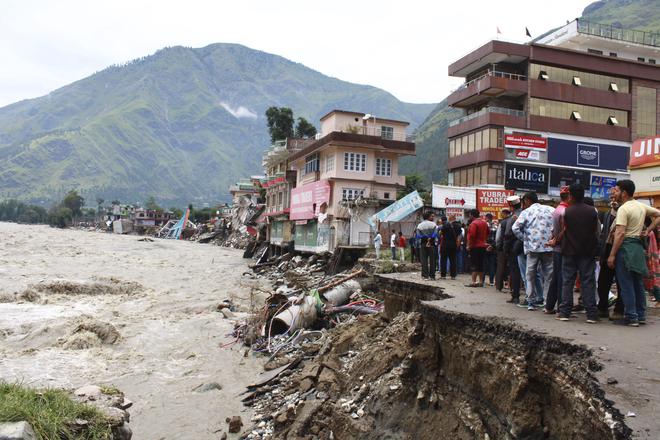In less than a month since the onset of monsoon this year, from June 24 to July 10, over 41 landslides, 29 flash floods, and one cloud burst have occurred so far in Himachal Pradesh, with relentless rains pounding the hill State and leaving behind a trail of destruction. At least 80 people have lost their lives in the rain-related incidents. This has yet again triggered a debate over whether the ongoing ‘fury of nature’ is a manmade disaster inevitably visited upon the Himalayan region.
Incessant rains have caused havoc in several parts of Himachal Pradesh resulting in the loss of human lives and livestock, damage to several roads, National Highways, vehicles, and residential and commercial buildings, with hundreds left stranded, and losses estimated at crores of rupees.
Studies and experts have repeatedly suggested that landslides, cloud bursts, flash floods, avalanches, and droughts are hazards of immediate concern in Himachal Pradesh. The focus of government agencies and policymakers should be on prevention rather than management, they point out.
Manshi Asher, an environmentalist associated with the Himdhara Environment Research and Action Collective, an advocacy and research group working on issues of environmental justice and forest rights in the Himalayan region, said the flash floods in Himachal Pradesh had been evidently triggered by excess rainfall but they had also been “intensified” by muck and debris dumped along streams and rivers, apart from the land- and mud slides that came with the downpour.

“These are directly or indirectly caused due to land use change, erosion caused by deforestation, and slopes destabilised by construction. Building along the river bed in floodplains blocks the path of the river in spate and is harmful. But it’s the excavation, tree felling and digging of slopes for roads, highways, buildings and dams that causes landslides which in turn lead to flash floods, causing damage downstream,” Ms. Asher said.
“Prevention calls for a policy overhaul and strengthening of regulatory measures on the part of the government. What we have seen in the last decade-and-a-half is mega infrastructure-led growth and easing of environmental norms,” she added.
Also read: Explained | North India’s monsoon mayhem is a confluence of factors
Himachal Pradesh’s State of the Environment Report, released in 2022 by the Department of Environment, Science and Technology, points out that mountain areas are highly vulnerable to natural disasters, and development over the years has compounded the problem by upsetting the natural balance of various physical processes. The reports added that the increased pressure on the mountain environment has contributed in some measure to environmental problems such as landslides, land subsidence, removal of vegetation and soil erosion. According to one estimate, about 58.36% of land is subjected to intense soil erosion, most of which is located in the Himalayas, and Himachal Pradesh, which forms part of the Western Himalayas, is environmentally fragile and ecologically vulnerable, it said.
According to the State’s 2015 Landslide Hazard Risk Assessment, the hilly areas of Himachal Pradesh are vulnerable to landslides due to geological, meteorological and anthropogenic factors. The hydro-meteorological conditions and fragile structural fabric of the geological strata of Himachal Pradesh increase the possibility of landslides. Anthropogenic factors such as removal of vegetation cover, and overloading of slopes also contribute to a great extent. Development activities, including the construction of roads, tunnels, and excavation for hydro projects have further accentuated the problem, it added.
Naresh Chauhan, Principal Advisor to the Chief Minister of Himachal Pradesh, said that the current spell of rains was unprecedented, and while there’s no control over a natural calamity, there’s a need to ensure that debris and muck are not thrown into rivers or rivulets during the construction of roads, projects or dwellings. Also, construction near rivers needs to be regulated in a manner that unfortunate incidents could be averted, he added.







